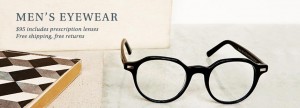 We are starting to see new traditionally offline industries popup online. Since eCommerce has been around for 15+ years, these are some of the latecomers. Some characteristics of the types of businesses that I am referring to (and describe below) are still primarily driving people into stores because: Goods are difficult to return because of size, customization or goods that carry strong personal preferences (you want to touch / feel prior to purchase). It feels that historically these retail business have thrived on the lack of information available to consumers, which is the opposite of my last post on Big Data in Education. The opportunity is that these are usually products that have strong margins.
We are starting to see new traditionally offline industries popup online. Since eCommerce has been around for 15+ years, these are some of the latecomers. Some characteristics of the types of businesses that I am referring to (and describe below) are still primarily driving people into stores because: Goods are difficult to return because of size, customization or goods that carry strong personal preferences (you want to touch / feel prior to purchase). It feels that historically these retail business have thrived on the lack of information available to consumers, which is the opposite of my last post on Big Data in Education. The opportunity is that these are usually products that have strong margins.
My opinion is that the next generation of disruption for these products will be a hybrid of online / offline sales. Here are three industries that are prime to take advantage of a hybrid model, which should pave the way for better prices and purchasing experiences for consumers and a lower cost structure than is currently in place for operators:
- Eyeglasses – This is far down the path thanks to folks like Warby Parker, who is starting to take a swipe from traditional players such as LensCrafters. Warby Parker offers retail locations in big cities, virtual try-ons, and they will even send frames to your house to try on. From a price perspective, with a coupon, the median price of a pair of glasses from LensCrafters is $260, while most of Warby Parkers glasses are $95 shipped with no tricks and great customer service. I have ordered a pair and was blown away by the experience.
- Beds / Mattress – This is one industry that I can not fully wrap my arms around. The same bed is sold to 10 different
chains under 10 different brand names. Is their another business that still plays games like that? I think that this has been a hold up for consumers getting a fair shake and makes it virtually impossible to compare pricing. Simple concept here is that a basic retail store with options of firmness / softness could give you all of the information that you will need to pull the trigger on purchasing a bed online – which can then be customized for size and other basic info that consumers can visually make decisions on and can be shipped / delivered to your door a few days later. An entrepreneur could take to a pricing mechanism similar to Warby Parker and implement a flat rate per size of bed, my guess of which would represent significant savings off of todays typical retail pricing. - Sofas – similar to beds, when you are purchasing a sofa you have very little basis for comparison and it is one of those spaces that is difficult to compare and you want to sit on a sofa to gauge comfort prior to purchasing. There are a limited amount of options when looking at a sofa – why not have the basic samples available at a retail store to try out and then build your sofa from the comfort of your home and even drop it into a picture of your living room, similar to a virtual try on.
The rest of the way for these spaces to succeed online has clearly been paved by everyone else that is out there selling on the web, it will be exciting to see how these verticals play out.